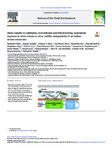Metal transfer to sediments, invertebrates and fish following waterborne exposure to silver nitrate or silver sulfide nanoparticles in an indoor stream mesocosm
| dc.contributor.author | Clark, Nathaniel | |
| dc.contributor.author | Vassallo, J | |
| dc.contributor.author | Silva, PV | |
| dc.contributor.author | Silva, ARR | |
| dc.contributor.author | Baccaro, M | |
| dc.contributor.author | Medvešček, N | |
| dc.contributor.author | Grgić, M | |
| dc.contributor.author | Ferreira, A | |
| dc.contributor.author | Busquets-Fité, M | |
| dc.contributor.author | Jurkschat, K | |
| dc.contributor.author | Papadiamantis, AG | |
| dc.contributor.author | Puntes, V | |
| dc.contributor.author | Lynch, I | |
| dc.contributor.author | Svendsen, C | |
| dc.contributor.author | van den Brink, NW | |
| dc.contributor.author | van Gestel, CAM | |
| dc.contributor.author | Loureiro, S | |
| dc.contributor.author | Handy, Richard | |
| dc.date.accessioned | 2022-08-23T16:12:16Z | |
| dc.date.issued | 2022-12-01 | |
| dc.identifier.issn | 1879-1026 | |
| dc.identifier.issn | 1879-1026 | |
| dc.identifier.other | 157912 | |
| dc.identifier.uri | http://hdl.handle.net/10026.1/19559 | |
| dc.description.abstract |
The fate of engineered nanomaterials in ecosystems is unclear. An aquatic stream mesocosm explored the fate and bioaccumulation of silver sulfide nanoparticles (Ag2S NPs) compared to silver nitrate (AgNO3). The aims were to determine the total Ag in water, sediment and biota, and to evaluate the bioavailable fractions of silver in the sediment using a serial extraction method. The total Ag in the water column from a nominal daily dose of 10 μg L-1 of Ag for the AgNO3 or Ag2S NP treatments reached a plateau of around 13 and 12 μg L-1, respectively, by the end of the study. Similarly, the sediment of both Ag-treatments reached ~380 μg Ag kg-1, and with most of it being acid-extractable/labile. The biota accumulated 4-59 μg Ag g-1 dw, depending on the type of Ag-treatment and organism. The oligochaete worm, Lumbriculus variegatus, accumulated Ag from the Ag2S exposure over time, which was similar to the AgNO3 treatment by the end of the experiment. The planarian, Girardia tigrina, and the chironomid larva, Chironomus riparius, showed much higher Ag concentrations than the oligochaete worms; and with a clearer time-dependent statistically significant Ag accumulation relative to the untreated controls. For the pulmonate snail, Physa acuta, bioaccumulation of Ag from AgNO3 and Ag2S NP exposures was observed, but was lower from the nano treatment. The AgNO3 exposure caused appreciable Ag accumulation in the water flea, Daphnia magna, but accumulation was higher in the Ag2S NP treatment (reaching 59 μg g-1 dw). In the rainbow trout, Oncorhynchus mykiss, AgNO3, but not Ag2S NPs, caused total Ag concentrations to increase in the tissues. Overall, the study showed transfer of total Ag from the water column to the sediment, and Ag bioaccumulation in the biota, with Ag from Ag2S NP exposure generally being less bioavailable than that from AgNO3. | |
| dc.format.extent | 157912-157912 | |
| dc.format.medium | Print-Electronic | |
| dc.language | en | |
| dc.language.iso | eng | |
| dc.publisher | Elsevier | |
| dc.subject | Freshwater sediments | |
| dc.subject | Engineered nanomaterials | |
| dc.subject | Benthic and planktonic invertebrates | |
| dc.subject | Trout | |
| dc.subject | Silver uptake | |
| dc.subject | Metal partitioning | |
| dc.title | Metal transfer to sediments, invertebrates and fish following waterborne exposure to silver nitrate or silver sulfide nanoparticles in an indoor stream mesocosm | |
| dc.type | journal-article | |
| dc.type | Journal Article | |
| plymouth.author-url | https://www.webofscience.com/api/gateway?GWVersion=2&SrcApp=PARTNER_APP&SrcAuth=LinksAMR&KeyUT=WOS:000863309000007&DestLinkType=FullRecord&DestApp=ALL_WOS&UsrCustomerID=11bb513d99f797142bcfeffcc58ea008 | |
| plymouth.volume | 850 | |
| plymouth.publication-status | Published | |
| plymouth.journal | Science of the Total Environment | |
| dc.identifier.doi | 10.1016/j.scitotenv.2022.157912 | |
| plymouth.organisational-group | /Plymouth | |
| plymouth.organisational-group | /Plymouth/Faculty of Science and Engineering | |
| plymouth.organisational-group | /Plymouth/Faculty of Science and Engineering/School of Biological and Marine Sciences | |
| plymouth.organisational-group | /Plymouth/REF 2021 Researchers by UoA | |
| plymouth.organisational-group | /Plymouth/REF 2021 Researchers by UoA/UoA06 Agriculture, Veterinary and Food Science | |
| plymouth.organisational-group | /Plymouth/Research Groups | |
| plymouth.organisational-group | /Plymouth/Research Groups/Marine Institute | |
| plymouth.organisational-group | /Plymouth/Users by role | |
| plymouth.organisational-group | /Plymouth/Users by role/Academics | |
| dc.publisher.place | Netherlands | |
| dcterms.dateAccepted | 2022-08-04 | |
| dc.rights.embargodate | 2022-8-24 | |
| dc.identifier.eissn | 1879-1026 | |
| dc.rights.embargoperiod | Not known | |
| rioxxterms.versionofrecord | 10.1016/j.scitotenv.2022.157912 | |
| rioxxterms.licenseref.uri | http://www.rioxx.net/licenses/all-rights-reserved | |
| rioxxterms.licenseref.startdate | 2022-08-08 | |
| rioxxterms.type | Journal Article/Review |


